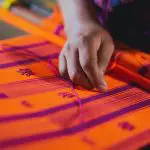When it comes to choosing the best silk screen print frame, it's like finding the perfect tool for a master craftsman. The right frame can make all the difference in achieving precise, professional results. Understanding the nuances of frame material, mesh count, sizing, tensioning systems, and additional features is crucial for mastering the art of silk screen printing.
In this guide, you'll learn how to navigate the myriad options available and select the perfect frame to elevate your printing projects to the next level. Let's delve into the key considerations that will empower you to make an informed and confident choice for your silk screen print frame.
Key Takeaways
- Frame material choice affects durability and print quality
- Mesh count selection is crucial for optimal printing results
- Consider frame size to accommodate artwork dimensions and stability
- High-quality tensioning system ensures secure stretching of mesh for precise printing
Frame Material Options
When selecting a silk screen print frame, you should always consider the various material options available to ensure durability and quality in your prints.
Two primary material options for silk screen print frames are aluminum and wood. Aluminum frames are lightweight, strong, and resistant to warping, making them an excellent choice for long-term use. They also provide a smooth and flat surface for better print quality.
On the other hand, wood frames are known for their affordability and are suitable for smaller print runs. However, they're more prone to warping and may require frequent re-tensioning.
Another aspect to consider is the choice between stainless steel and plastic for the fastening and corner elements of the frame. Stainless steel fasteners offer durability and stability, ensuring that the frame maintains its shape during the printing process. In contrast, plastic fasteners may be more prone to wear and tear over time.
Understanding Mesh Count
To understand mesh count, you should consider how it affects the quality and detail of your prints, especially when choosing the best silk screen print frame. Mesh count is a crucial factor in determining the level of detail and intricacy that can be achieved in a print. The mesh count refers to the number of threads per inch on the screen and plays a significant role in determining the amount of ink that's deposited onto the substrate. A higher mesh count results in finer details and is suitable for printing intricate designs, while a lower mesh count is better suited for printing bolder, larger designs.
Understanding the importance of mesh count is essential for achieving the desired print quality. Different mesh counts have varying ink viscosity requirements. For instance, lower mesh counts require thicker inks to prevent them from bleeding through, while higher mesh counts work best with thinner inks to ensure proper penetration and detail. Therefore, selecting the appropriate mesh count is crucial for achieving optimal printing results and ensuring that the ink viscosity matches the screen's specifications.
Sizing Considerations
Consider the dimensions of your artwork when selecting the appropriate screen size for your silk screen print frame. The frame size should be large enough to accommodate your entire design, with some extra space around the edges for frame stability and proper tensioning. When choosing the frame size, measure the dimensions of your artwork and add at least 2-3 inches to each side to ensure that the screen will adequately cover the entire design and provide enough room for proper tensioning. This extra space will also allow for easy handling and registration when aligning the design for printing.
In addition to the artwork dimensions, consider the space available in your work area. Ensure that the chosen frame size fits comfortably on your printing table or work surface without any obstructions. It's important to maintain a balance between the size of the artwork, frame stability, and ease of handling during the printing process.
Tensioning Systems
To ensure proper tensioning of your silk screen print frame, use a high-quality tensioning system that provides uniform and secure stretching of the mesh across the frame. Tensioning systems play a crucial role in maintaining the integrity of the screen, ensuring that the mesh remains taut for consistent and precise printing. When selecting a tensioning system, consider the type of frame you are using and the level of tension required for your specific printing needs.
Below is a comparison table of common tensioning tools used in frame maintenance:
| Tensioning Tools | Description | Benefits |
|---|---|---|
| Manual Stretchers | Hand-operated devices for stretching mesh | Cost-effective and portable |
| Pneumatic Stretchers | Use air pressure to achieve proper tension | Provides uniform tension distribution |
| Mechanical Tensioners | Utilize mechanical force for stretching | Offers precise and adjustable tension |
Regular maintenance of your tensioning system is essential to ensure optimal performance and longevity of your silk screen print frame. Periodic inspections and adjustments will help to maintain consistent tension, resulting in high-quality prints. Selecting the right tensioning system and maintaining it properly will contribute to the overall success of your silk screen printing projects.
Additional Features to Look For
When selecting additional features for your silk screen print frame, ensure they enhance the tensioning system to maintain consistent and precise printing. Frame durability is a critical factor to consider. Look for frames made from sturdy materials like aluminum or steel, as they offer long-lasting performance and can withstand the tension required for high-quality prints. Additionally, consider features such as reinforced corners or welded joints, which contribute to the overall durability of the frame and help maintain proper tension over time.
Another essential aspect to focus on is print quality. Look for frames that offer micro-registration capabilities, as this allows for fine adjustments to achieve precise and accurate print alignment. Features like adjustable tension knobs and ergonomic handles can also contribute to better print quality by enabling you to fine-tune the tensioning system with ease, resulting in sharp and consistent prints.
Furthermore, consider frames with compatibility for various mesh types and thicknesses, as this versatility can enhance the range of designs you can print with optimal quality. Lastly, look for frames that offer easy and quick setup, ensuring that you can efficiently prepare the frame for printing, ultimately contributing to improved overall print quality.
Frequently Asked Questions
Can Silk Screen Print Frames Be Used for Other Types of Printing, Such as Vinyl or Digital Printing?
Yes, silk screen print frames can be used for vinyl and digital printing. You can customize the frame for different printing methods. Consider the specific needs of your printing projects when choosing the best silk screen print frame.
Are There Any Environmental Considerations to Take Into Account When Choosing a Silk Screen Print Frame Material?
When choosing a silk screen print frame, consider the environmental impact. Opt for sustainable materials like bamboo or aluminum. These options reduce the frame's carbon footprint and contribute to a more eco-friendly printing process.
Can Silk Screen Print Frames Be Custom Made to Fit Non-Standard Print Sizes?
Yes, silk screen print frames can be custom made to fit non-standard print sizes. This allows for flexibility in your printing projects. When choosing, consider frame durability to ensure it will withstand the demands of your printing needs.
Is It Possible to Re-Tension a Silk Screen Print Frame After It Has Been Used Multiple Times?
Yes, it is possible to re-tension a silk screen print frame after multiple uses. You can re-tension the frame by using re-tensioning tools and following the re-tensioning process to ensure a tight and even screen.
What Are the Best Practices for Storing and Maintaining Silk Screen Print Frames When They Are Not in Use?
When not in use, store silk screen print frames in a clean, dry area, away from direct sunlight or extreme temperatures. Regularly inspect for any damage or wear and tear, and maintain by cleaning with mild soap and water.






